What Age Should You Read Aloud Little House in the Big Woods
I take a confession to make: I was born in the 1970s. When I was growing up, the Footling House On The Prairie Tv set series was in its first run. Information technology was nevertheless on the air the Christmas I turned five, when I received my very own 9-volume boxed set of Laura Ingalls Wilder's classic children'due south series, based on her memories of a childhood shaped past w migration in the late 19th century United States.
I learned how to read on those books, at my male parent'due south side. Virtually nights my male parent came home from work long after my bedtime. But on Saturdays, I would sit in his lap and he would read a chapter to me. Over time, it switched to me reading a folio, and so him, and so me once more. Eventually, I was doing all the reading, with his help.
And so when Kimmie'south fifth birthday approached, I bought the girls their very own Piddling House boxed set. And eagerly looked forwards to revisiting these love books from my childhood.
Never thinking for a moment that there could be annihilation problematic about this action, or this choice.
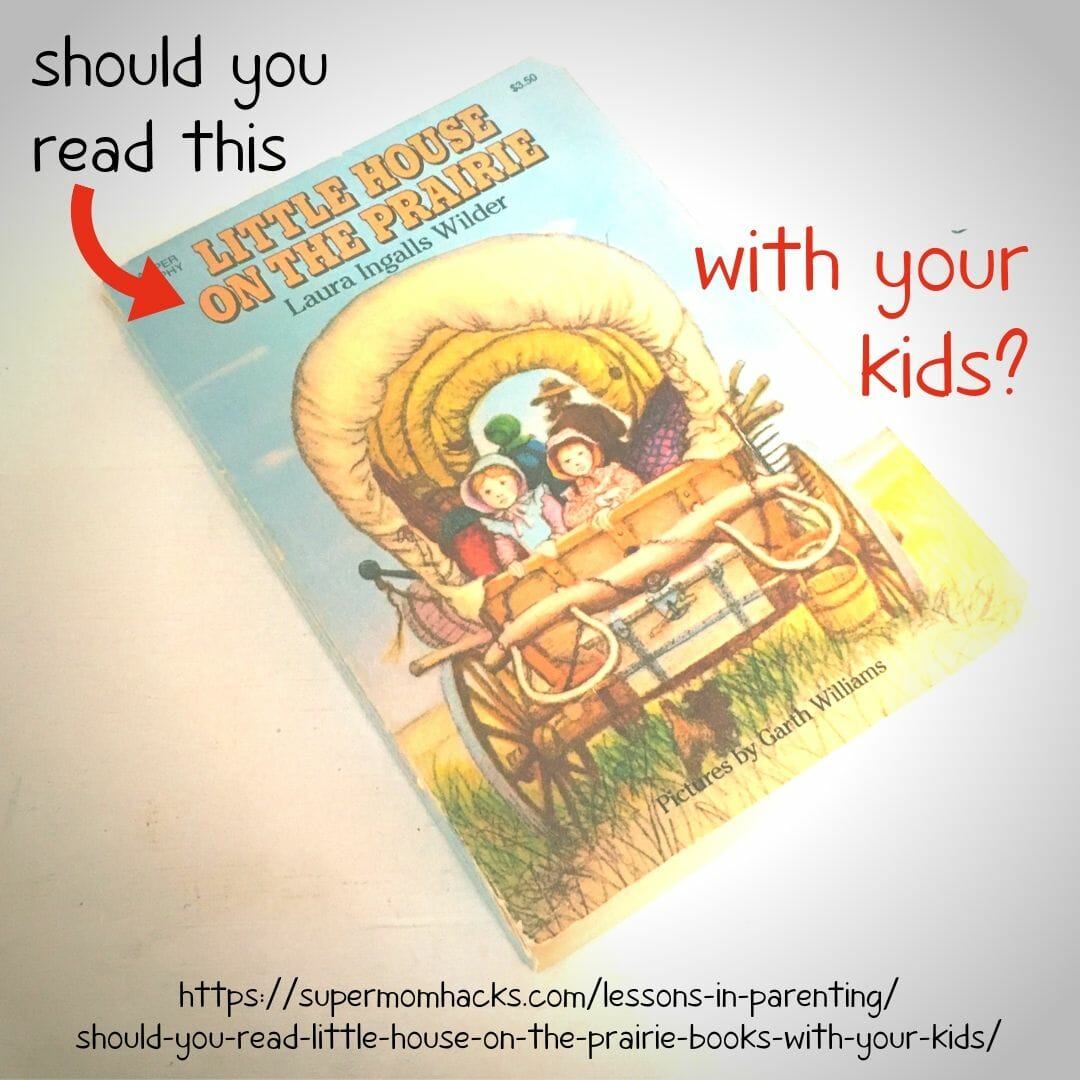
So what? (a.k.a. What'southward wrong with this picture?)
Equally someone who was already of "avant-garde maternal age" with her first pregnancy, I realize that well-nigh of my readers with young kids were born in the 1980s, or even the '90s. And then you may have missed these classics during your formative years.
My girls were already reading by the time nosotros started working through the Little House books together in 2018. We're lucky if we get to read a chapter i-2 nights a week, which means that nosotros're working through the gear up very s-l-o-w-50-y. (Nosotros only read a chapter on nights when it's my turn for bedtime duty, and they're both ready for bed with fourth dimension to spare.)
At beginning, nosotros took turns reading pages, or I had the girls have turns while I listened. They're perfectly fluent readers, just they do enough reading on their own that it's become something we practise together with Mama being the only i reading.
And all the same, I had no idea what I was getting into when nosotros starting time started on this historic series. Written long ago about an fifty-fifty longer-ago time.
That'due south why I'yard writing this mail. To warn you about what you should expect earlier revisiting babyhood favorites with your children.
Especially if those childhood favorites accept anything to exercise with the often-messy history of the Us.
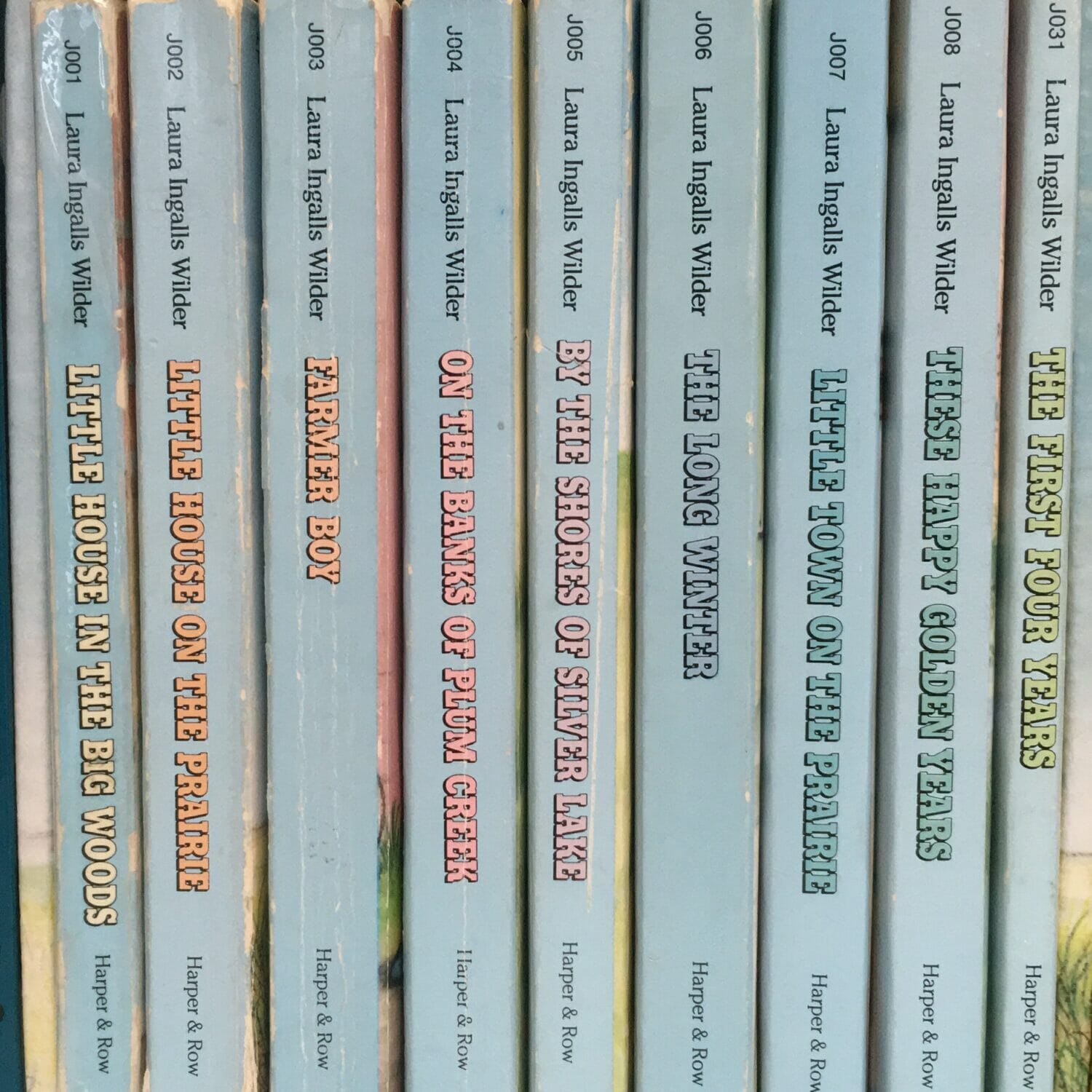
What parents demand to know before reading Little Firm with their kids:
I honestly don't remember having a single discussion with my father virtually the books as we were reading them. At the fourth dimension, the events they described had taken place a century before, just the books themselves were simply possibly 4 decades old.
Nowadays, the books themselves are twice as old. A lot has changed in twoscore years.
For example, did y'all catch the 2018 controversy about the renaming of the Laura Ingalls Wilder award in children's literature?
The award is given out annually by the American Library Clan, to acknowledge outstanding contributions in children'south literature. Laura herself was the start recipient, in 1954.
But – conduct with me for a moment – the 2018 rebranding of the honor into the Children'southward Literature Legacy Award reflects a 21st-century sensibility of cultural sensation. Including the cumulative bear upon of microaggressions over fourth dimension upon those who find themselves at a disadvantage within prevailing or historic ability structures.
To put information technology more simply, there's a lot of stuff in the Petty House books that doesn't reverberate the way we alive nowadays. Or, more chiefly, the lessons my husband and I want to teach our children about interacting with those who are different than us.
Non to mention that at that place'south a lot of other potentially problematic stuff in these books – things that kids should have a grownup's aid with processing.
Other potential pitfalls of reading the Little House series
Our commencement lesson on this came early on, in Chapter iii of the start volume, Little Firm In The Big Forest. Chapter three, "The Long Rifle," goes into exhaustive particular most the girls helping Pa make more bullets for his gun every evening, so he tin can go hunting the next day.
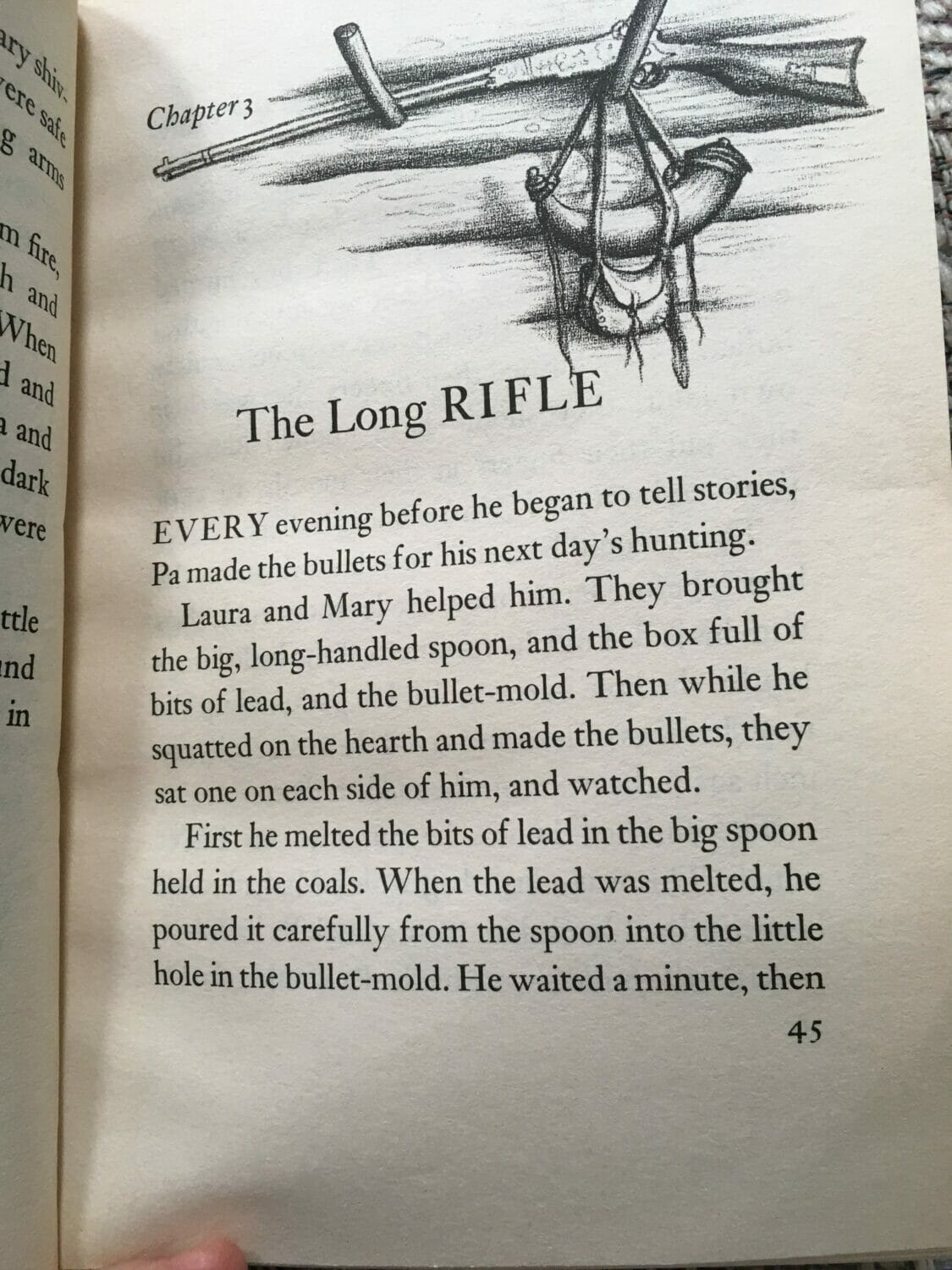
My late father was a card-conveying member of the NRA, and my family grew upwardly eating whatever he'd caught in our backyard, equally oft as he could catch it. My girls know this. They also know that my brother Evan and his wife still hunt whenever they accept the chance.
But what made this chapter challenging to read with them was the fact that nosotros read it a week after the Parkland school shooting. When, despite our attempts to shield them from the more than graphic accounts, the girls had been hearing about gun violence against children for a week straight on the news.
THAT took some explaining. Only the resulting chat I had with them, most this very different fourth dimension and this very unlike historical context, was where the idea for this postal service began.
So should parents read Little House on the Prairie books with their kids?
In a word, Yep.Don't let your children read them on their own. They need an adult with them while they read, to help with disquisitional thinking and historical context.
Think back to when your kids were toddlers and preschoolers, and you did "agile reading" activities with them. Where rather than just read them a book, you stopped to ask questions. (Fifty-fifty if they couldn't answer.) Questions similar
- Where is the cat? Tin you indicate to the dog?
- What color is this shape? How many green apples are there?
- What do you think is going to happen next?
This same skill set up is what you lot need to read Little House books with your school-age kids, to aid them process what's going on.
And in one case you lot approach reading these books with your children from an engaged, critical perspective, yous'll find that in that location are so many "teachable moments" (as those of u.s. with education backgrounds like to call them) that you tin can really unpack with your kiddos.
And best of all, these conversations volition not only build their cognition AND their critical thinking/reading skills, they'll strengthen the bond betwixt you at the same time.
Piece of cake teachable moments:
The extensive bullet-making example was really one of the easier "teachable moments" in the books. The timing of when nosotros got to it was most of what made that detail affiliate something to discuss at length.
But in that location are so many other ways in which these books can teach our children gratitude, for so many aspects of modern life that they have for granted. And in the process, we can talk about social differences, diff distribution of resources, and how very blessed they've been in their young lives.
Accept Laura'southward description of mealtimes. It was not uncommon for their everyday noon dinner, or evening supper, to consist of only 1 or 2 courses (one of those courses ordinarily being some sort of staff of life). Having something to eat with ane'southward bread was a existent treat, such as when Laura helped her mother harvest and procedure pumpkins inLittle House In The Big Woods:
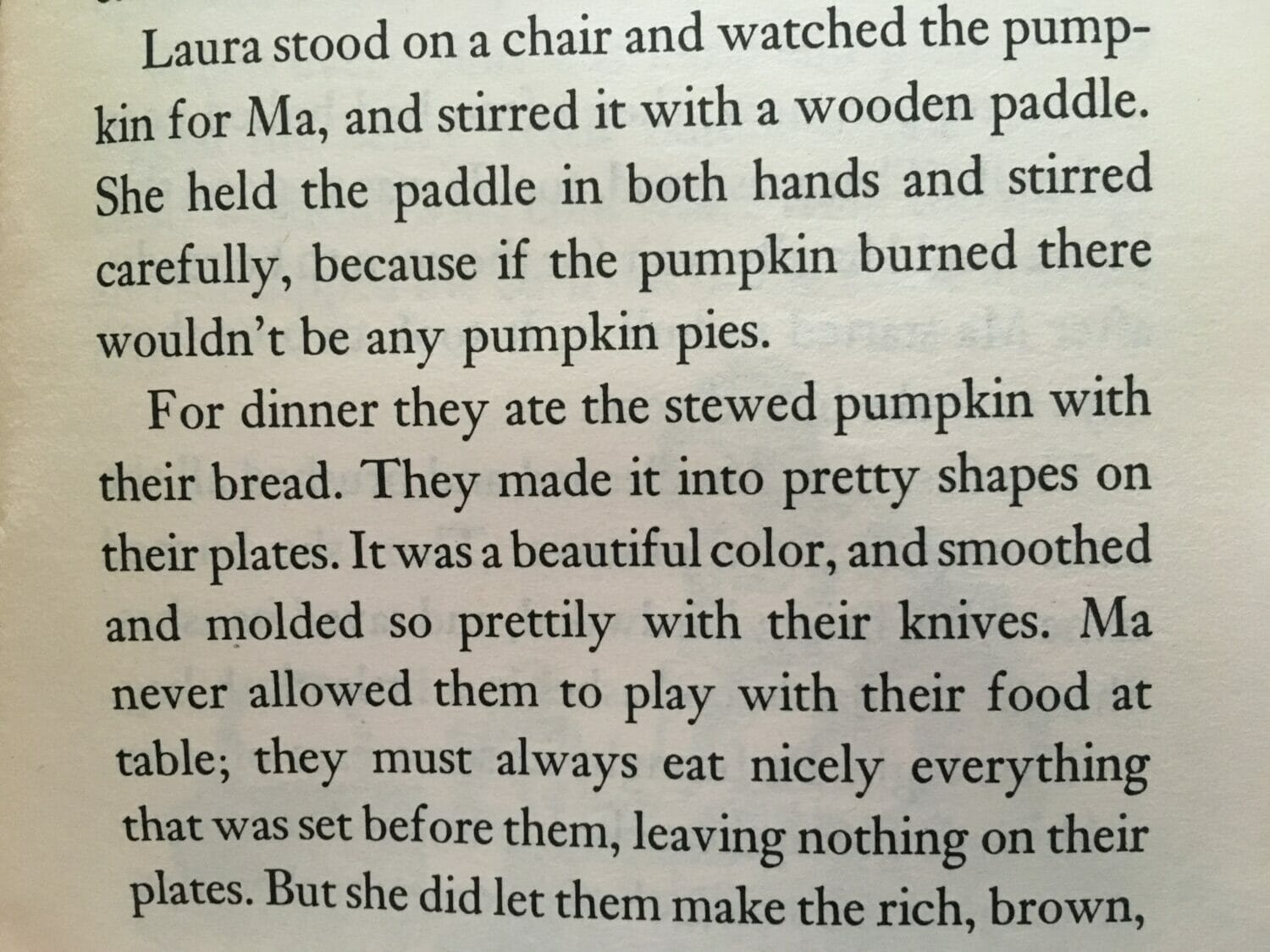
Did you catch that? The pumpkin was a special addition to a meal that would have otherwise been staff of life (and that's information technology!), far as we can tell. There are a lot of meals like this in Laura's childhood. Moreover, this meager nutrition stands in stark contrast to the much fuller tables that appeared at the childhood domicile of her futurity husband, Almanzo Wilder, in her book Farmer Boy.
At first, I fabricated sure to indicate out the Ingalls family'due south meager fare to the girls each time we encountered information technology. My kids aren't decumbent to being picky or sparing eaters, but we had several useful discussions about how fortunate nosotros are to exist able to eat the rich diverseness of foods we can access. And comparison Laura's upbringing to Almanzo's gave us an opportunity to consider social and economic inequalities and differences. Non to mention how difficult it was for Pa (Laura'southward male parent) to support his family, given the extraordinarily bad luck that seemed to follow him on most of his ventures.
The aforementioned is true for Christmases and birthdays. It's one thing for me to tell the girls that their great-grandfather grew upwards in an orphanage, where a good Christmas was an orangish on his bedside table (virtually Christmases, he got nix). It's another thing for them to compare their own (modest by today's standards) Christmas hauls with what counted for "a skilful Christmas" in Laura's childhood.
History lessons
But at that place are then many other things the girls are learning from these books, considering we are taking the fourth dimension to talk about each issue as it arises.
Some of the more blatant ones are the examples of racial differences. Specially treatment of (and attitudes toward) native peoples in Little House On The Prairie.
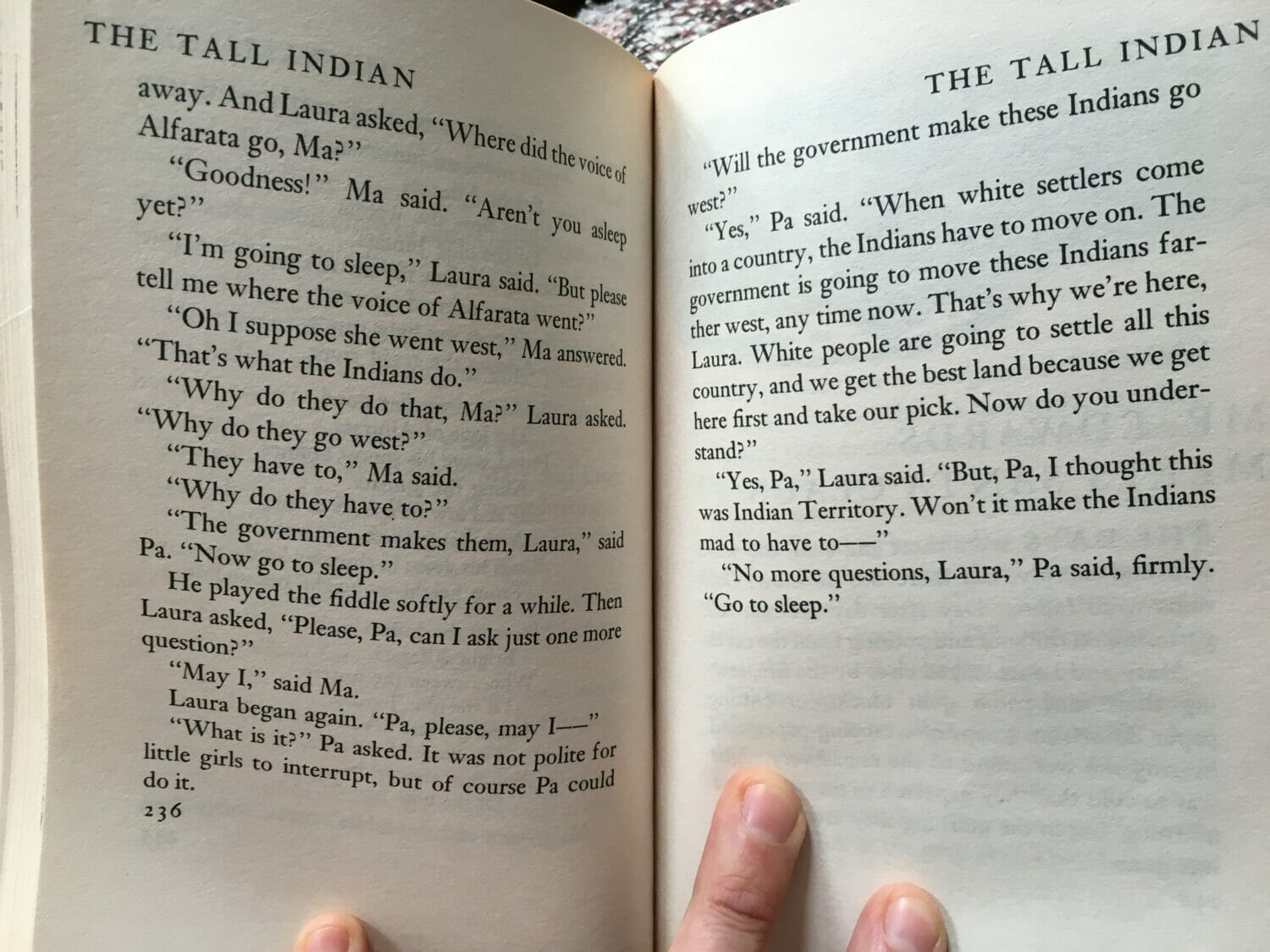
Those who make it to the finish ofLilliputian Firm on the Prairie know that Pa built his family a house in what'south now southeastern Kansas, on land that the U.S. Government had opened to homesteading.
Only one problem: the state was still actively occupied by the native peoples. And past the end of the book, the government decided it had made a mistake, and the state on which the Ingalls family lived was really part of the Osage reservation.
Significant the family unit had to pack up and leave their newly-built home, and just-planted fields, behind.
Which seems terribly unfair. Until one recalls thatthe Osage Nation had been there first, and the Ingalls family had been living on their country all along.
If you lot've ever watched two toddlers fighting over a toy, you lot know that even at this young age, kids take an innate sense of right and wrong, and particularly of "fair" and "not fair."
Passages like this are practically begging for a little "finish and put yourself in their shoes for a moment" conversation.
Bullying
And when you consider that the Ingalls family were actually the ones invading other people's space, information technology makes offhand assertions like "the only skillful Indian is a dead Indian" easier to unpack on a much deeper level with your littles.
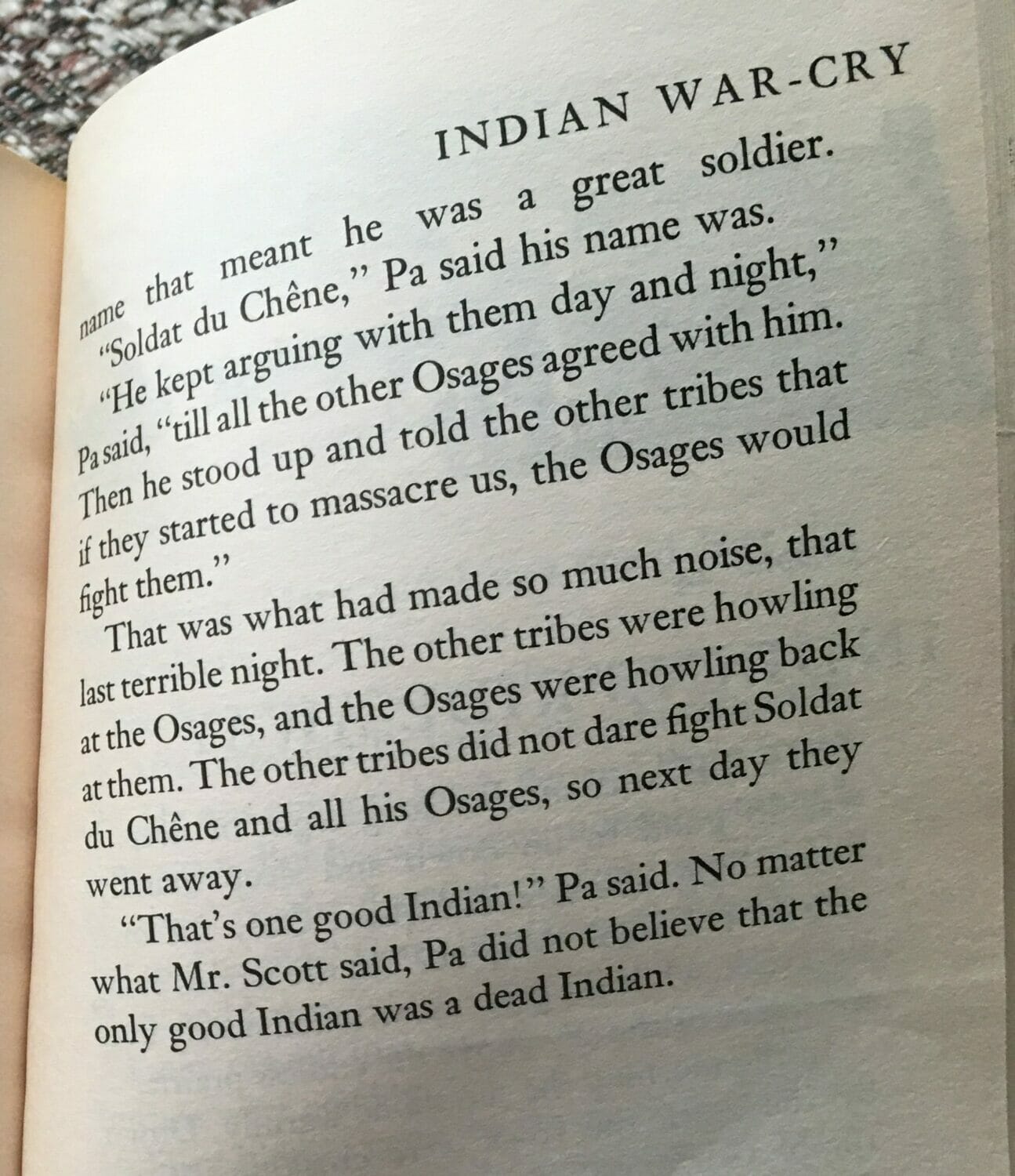
Equally someone who takes her kiddos to Lord's day School most weeks, information technology's ane thing for me to note with them that this kind of language doesn't sound very Christian or beloved-thy-neighbour. (Instead, it sounds downright dehumanizing.)
Simply in the larger context of the power dynamics going on – where the white settlers were actually interlopers on someone else's country – assertions about the inherent "goodness" (or lack thereof) of people who look different from you lot strike me equally the sort of thing a bully would say.
Of course, though, the superior attitudes of the white settlers in the book toward non-white peoples aren't the only instance of bullying. There's the more blatant examples from Laura's nemesis, Nellie Oleson, in On The Banks Of Plum Creek. Not only is Nellie portrayed every bit a spoiled brat, but she's downright vicious in her interactions with the Ingalls girls – whether yanking Laura'south pilus, or putting them down verbally.
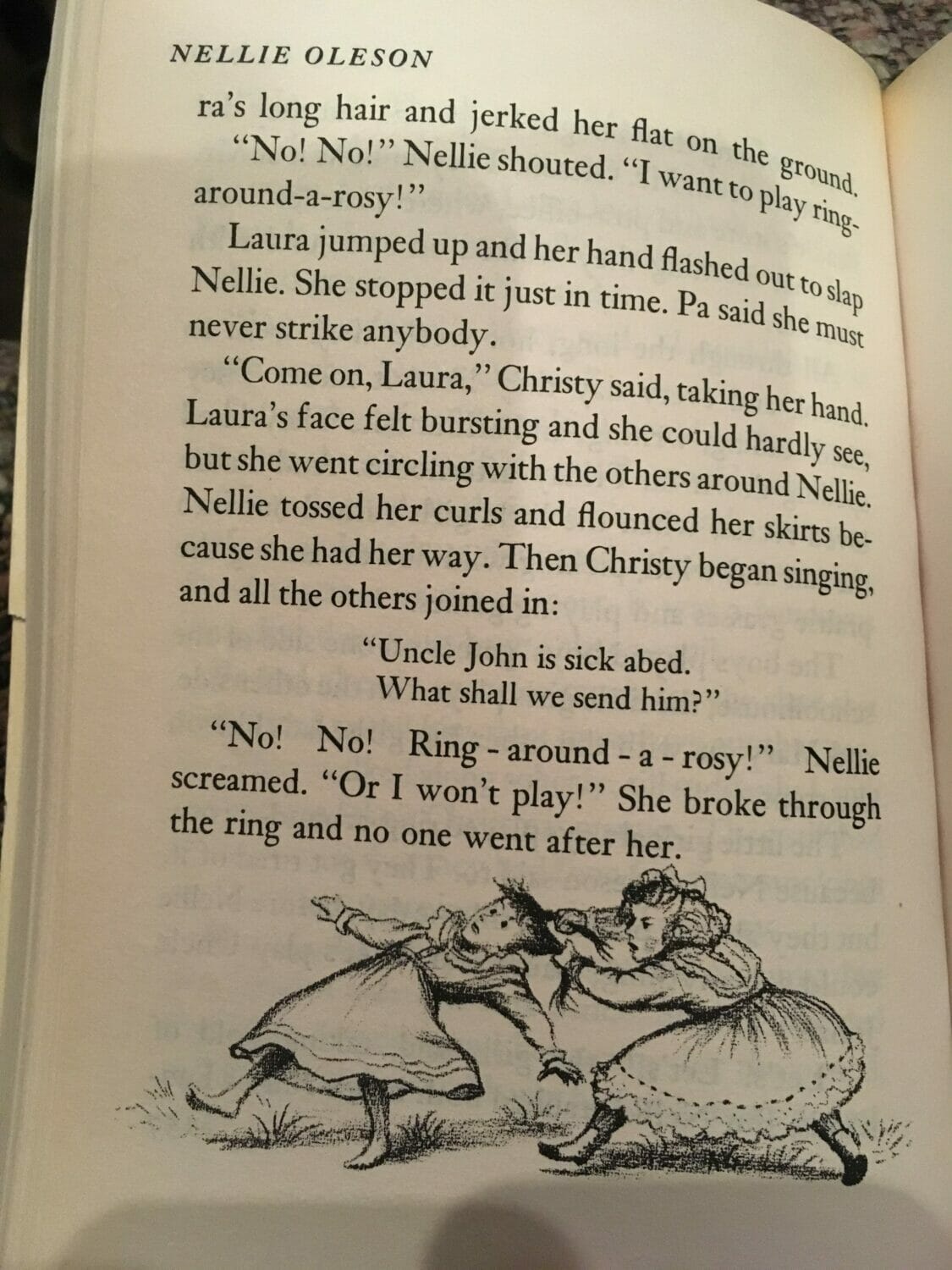
And for those of you lot who grew upward on Harry Potter instead of Little House: remember all of Harry Potter'southward epic ongoing struggle between the expert and the evil inside himself? Laura has plenty of like impulses from the dark side within her, though her inner angels more often than not prevail.
Privilege and Opportunity
And as Laura grows up in the books, my girls have closely tracked how old she and her sisters are in each volume, compared to my girls' ain ages. Right at present, we're up to book half dozen (The Long Wintertime), where Laura is a few years older than Kimmie is correct now.
And in this volume, Laura is so excited considering she's not working 12-plus-60 minutes days anymore (as she did for much of Volume 5), helping her family feed railroad employees and due west settlers in their boardinghouse. Which means that she finally has the opportunity to nourish school again.
Although this opportunity is a mixed blessing. Because she knows she needs to learn every bit much equally she tin ASAP, so she herself can become a instructor. (Her parents' idea, non hers.) Because in one case she lands a teaching job, she can help earn money so her blind sis can go to a special college for the blind.
In existent life, Laura started teaching school at historic period fifteen for this very reason. Needless to say, all of this blows my girls' minds.
My girls admire school, and soak up equally of learning they can. Helping with chores around the business firm is non their idea of a fun mode to spend all twenty-four hour period, every day.
Yet whenever Laura and her sisters need to help with the cleaning, or the dishes, or helping their parents earn a living, they do so – quickly and cheerfully (even if not cheerful on the inside). Without complaining.
Gratitude and Empathy
For my relatively privileged offspring, being reminded of all the many ways they are blessed, by reading a story with their mama, is invaluable. And having them try to put themselves in the shoes of these historical characters? Information technology's a perfect case of how reading these books together with your kids tin can help them learn empathy, along with slivers of history.
Yeah, your school-historic period kiddos and tweens may now know their colors and shapes – the sorts of things you used to inquire them about when reading to them earlier they could read for themselves. But taking the time to read these stories together with them, and to ask them hard questions most the content whenever they arise, will help their brains in so many other ways. Storytelling is a natural fashion for children to learn. Pausing stories to inquire questions not only keeps kids engaged, information technology besides helps their decision-making and self-regulation abilities to develop.
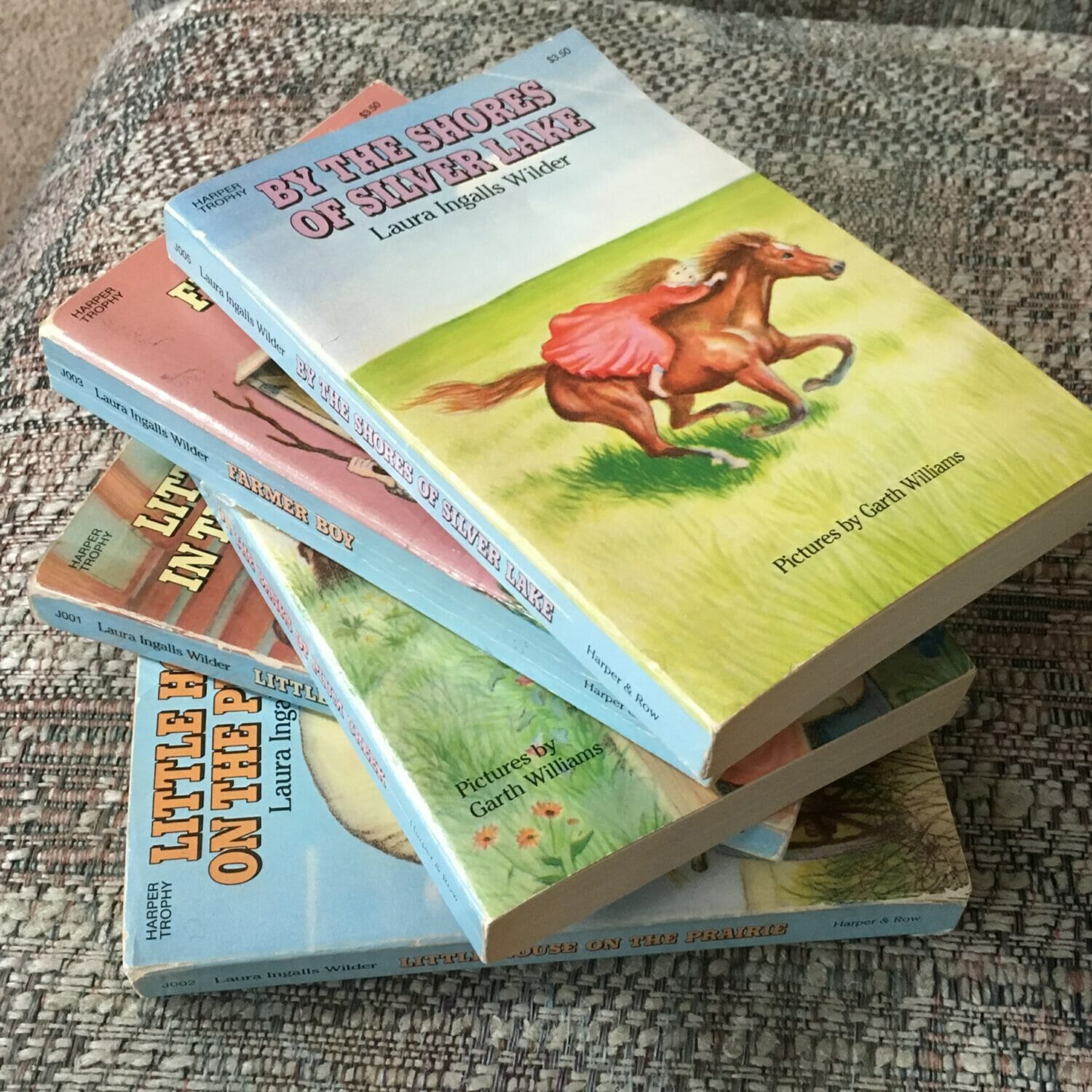
Then yep, by all ways, read these books WITH your children. They may not be used to you stopping to ask questions and brand observations anymore, as you lot might have when they were younger.
But asking the hard questions is the most valuable thing you lot can practice, to help them learn and then many of import life lessons from these archetype works. And the bonds you'll build through this process will exist priceless.
Accept you read Little Business firm On The Prairie books earlier? Have you read them with your kids? How did information technology become? Let us know in the comments!
If you enjoyed this postal service on whether you should read the Piddling House books with your kids, delight share it by pinning this image!
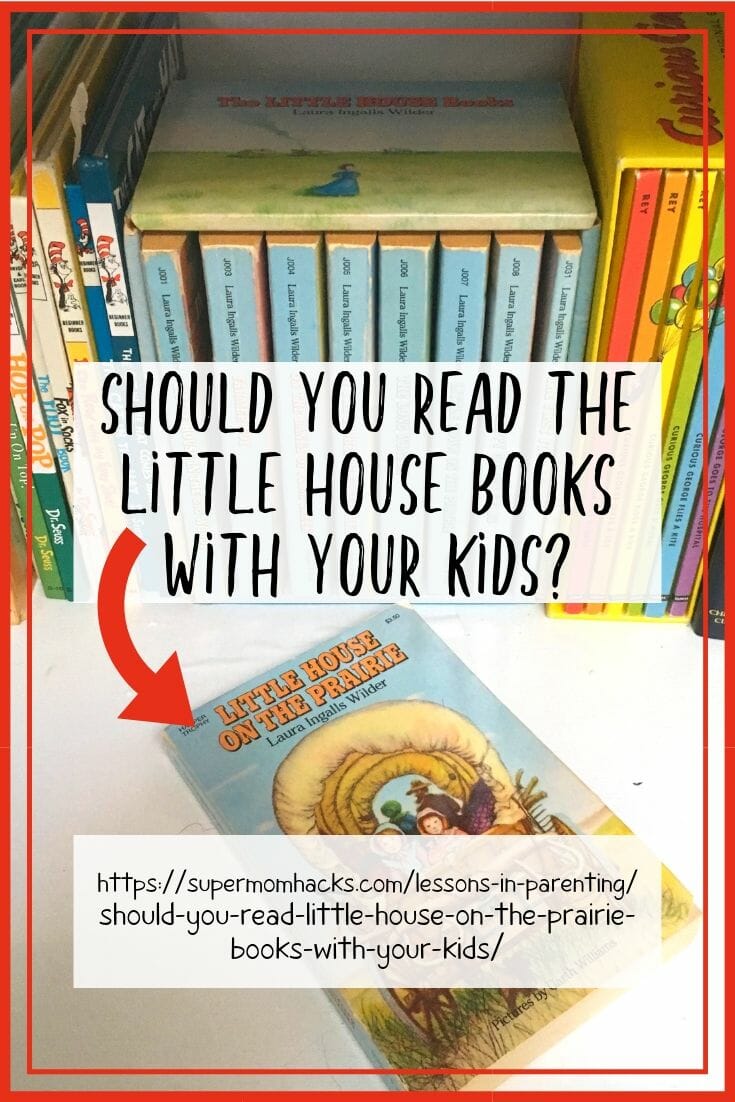
NOTE: This site contains affiliate links. I may earn a small commission from any purchases made through affiliate links, at no boosted cost to you. For more information, please read the total disclosure/privacy policy.
Follow Super Mom Hacks on Facebook, Instagram, Pinterest, and Twitter!
Or stay in the loop by joining our mailing list!
Source: https://supermomhacks.com/lessons-in-parenting/should-you-read-little-house-on-the-prairie-books-with-your-kids/
Postar um comentário for "What Age Should You Read Aloud Little House in the Big Woods"